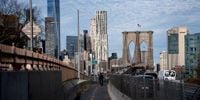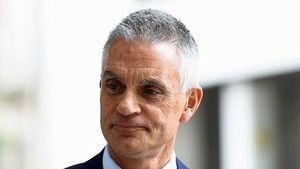Shifts in urban leadership and the fortunes of North America’s largest cities have rarely felt as dramatic as in the closing months of 2025. From the defeat of Calgary’s incumbent mayor to the swirling discontent in Toronto and the financial balancing act in New York City, a new chapter is being written—one with profound implications for city dwellers, artists, and the future of municipal governance.
On October 20, 2025, Calgary’s political landscape was rocked when sitting mayor Jyoti Gondek suffered a resounding defeat, finishing a distant third in her re-election bid with just 71,466 votes—only 20 percent of the ballots cast. As reported by Financial Post, this marked a stunning reversal from four years earlier, when Gondek had secured 176,344 votes, or 45 percent of the turnout. The reasons for her downfall were manifold: Gondek’s declaration of a climate emergency, her championing of over $200 million in taxpayer spending on the issue, and her defense of a controversial (and ultimately reversed) 2023 decision to cancel Canada Day fireworks, all contributed to mounting dissatisfaction. Add to that a series of steep property tax hikes—7.8 percent in 2024, 6.4 percent in 2025, and a planned 5.4 percent for 2026—and it’s little wonder voters looked elsewhere. The city’s new mayor, Jeromy Farkas, has already promised to reduce the planned tax increase for 2026, signaling a shift toward fiscal restraint.
Montreal, meanwhile, quietly underwent its own transition. The city bid farewell to retiring two-term mayor Valerie Plante, welcoming Soraya Martinez Ferrada, a former federal cabinet minister known for her centrist stance. The change, while less dramatic than Calgary’s, reflects a broader pattern of urban voters reconsidering their leadership in the face of economic and social pressures.
But nowhere is the sense of unrest more palpable than in Toronto. With the next municipal election less than a year away, polls reveal a city at a crossroads—and an electorate hungry for change. According to a November 2025 One Persuasion poll commissioned by A Better City Toronto, if the mayoral contest were held today between incumbent Olivia Chow and Councillor Brad Bradford (who has already declared his candidacy), Bradford would lead by a margin of 40 percent to 32 percent. The poll also found that former mayor John Tory, should he enter the race, would win a three-way contest with 36 percent support, ahead of Chow’s 33 percent and Bradford’s 29 percent. Most strikingly, around 70 percent of Toronto voters believe the city is heading in the wrong direction, and even one-third of those who supported Chow in 2023 now say it’s time for a new mayor.
These numbers are echoed in a November 2025 Canada Pulse Insights survey, which found that 64 percent of Torontonians think the city is on the wrong track, 51 percent rate Chow’s performance as poor, and 65 percent want new leadership. A Leger poll published in October 2025 showed Chow’s approval rating dropping to 43 percent, with a sharp increase in those who "strongly disapprove"—from 17 percent previously to 27 percent. Only nine percent of respondents said they "strongly approve" of her tenure.
Underlying this dissatisfaction are the hard realities of city life. Chow’s first two budgets delivered property tax hikes even steeper than those seen in Calgary, with Toronto homeowners facing a 9.5 percent increase in 2024 and another 6.9 percent in 2025. Meanwhile, important city services such as public transit and snow removal have struggled. Perhaps most alarming, the city’s homeless population more than doubled between April 2021 and October 2024. Economic woes compound the problem: a recent TD Economics report highlighted that Toronto’s unemployment rate climbed from 5.6 percent in April 2023 to 8.9 percent by September 2025, making it the fourth worst among Canada’s 41 major census metropolitan areas. The city’s youth unemployment rate stands at a staggering 20 percent. Despite a persistent housing crisis, construction hiring has been a "multi-year sore spot," with housing starts halving since mid-2023 and construction employment lagging well behind levels from two years ago.
Yet amid the political turbulence and economic uncertainty, the city’s creative spirit continues to shine—sometimes in unexpected ways. In November 2025, the art world took notice when Rama Duwaji, a celebrated animator, illustrator, and ceramist whose work has appeared in The New Yorker, The Washington Post, BBC, Apple, and Tate Modern, posted on Instagram a list titled "Things I saw in October that made me want to make art." Topping that list were paintings by Vancouver artist Lily Rose Fine. Duwaji, who is married to newly elected New York City mayor Zohran Mamdani, shared images of two of Fine’s works: As I Like It, a self-portrait exploring the pressures of personal expectation and the ebb and flow of identity, and Omen, a depiction of a moth among pearls that visualizes anxieties, superstition, and self-fulfilling prophecies.
Fine, who works out of an east Vancouver studio and is a graduate of the Ontario College of Art & Design University and the Royal Drawing School in London, learned of the high-profile endorsement through a friend. "My friend forwarded me her post! I hadn’t even caught the tag as I’m so bad at checking Instagram," Fine told Vancouver Sun. She was deeply honored, saying, "I was honoured, not just for the shout-out, but also the context of being something she saw that made her want to make art—that’s the highest compliment. Especially considering that a few days before the election, she was focusing on sharing art and her life instead of platforming her husband, which is interestingly subversive." Fine added that if she were a New Yorker, she would have voted for Duwaji’s husband, saying, "His win gives me hope for the future."
The intersection of art, politics, and urban life is perhaps nowhere more visible than in New York City, where the stakes for municipal finances have rarely been higher. According to Dow Jones & Company, the city’s tax receipts in fiscal 2025 totaled about $80 billion, with real estate alone contributing roughly $35 billion and personal taxes another $18 billion. The financial sector, real estate, construction, tourism, and retail trade remain the main engines of revenue. But as historian Arnold Toynbee warned in his 1970 work Cities on the Move, big cities can become impoverished and insolvent—sometimes never recovering. The article notes that many of the patterns Toynbee described now seem to apply to New York, underscoring the fragility of urban prosperity.
As North America’s major cities grapple with economic headwinds, leadership transitions, and a restless electorate, the challenges ahead are formidable. Yet, as artists like Lily Rose Fine remind us, the creative pulse of the city endures—even as its politics and fortunes ebb and flow. Next year’s elections in Toronto and the ongoing recalibration in cities like Calgary and Montreal will test whether new leaders can reverse declining trends and restore public confidence. For now, city dwellers and observers alike are left to ponder: can these urban giants adapt and thrive, or will they repeat the mistakes of the past?
Whatever the outcome, it’s clear that the future of North America’s cities will be shaped not just by the choices of mayors and policymakers, but by the resilience and imagination of the people who call them home.





